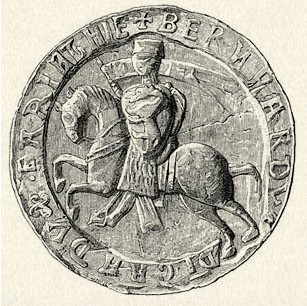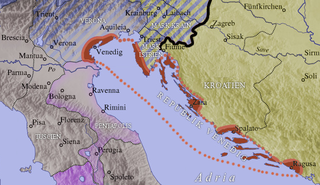
Hedwig of Silesia, also Hedwig of Andechs, a member of the Bavarian comital House of Andechs, was Duchess of Silesia from 1201 and of Greater Poland from 1231 as well as High Duchess consort of Poland from 1232 until 1238. She was reported in the two-volume historical atlas of Herman Kinder and another author to have been great in war and defended from the Teutonic Knights. She was canonized by the Catholic Church in 1267 by Pope Clement IV.

Gertrude of Merania was Queen of Hungary as the first wife of Andrew II from 1205 until her assassination. She was regent during her husband's absence.
Louis I, called the Kelheimer or of Kelheim, since he was born and died at Kelheim, was the Duke of Bavaria from 1183 and Count Palatine of the Rhine from 1214. He was a son of Otto I and his wife Agnes of Loon. Louis was married to Ludmilla, a daughter of Duke Frederick of Bohemia.

Berthold IV, a member of the House of Andechs, was Margrave of Istria and Carniola. By about 1180/82 he assumed the title of Duke of Merania, referring to the Adriatic seacoast of Kvarner which his ancestors had conquered in the 1060s and annexed to Istria and Carniola.

The Marchof Carniola was a southeastern state of the Holy Roman Empire in the High Middle Ages, the predecessor of the Duchy of Carniola. It corresponded roughly to the central Carniolan region of present-day Slovenia. At the time of its creation, the march served as a frontier defense against the Kingdoms of Hungary and Croatia.
Otto III, a member of the House of Andechs, was the count of Burgundy from 1231 and the last duke of Merania from 1234 until his death.

Otto I, a member of the House of Andechs, was Duke of Merania from 1204 until his death. He was also Count of Burgundy from 1208 to 1231, by his marriage to Countess Beatrice II, and Margrave of Istria and Carniola from 1228 until his death.

Bernhard von Spanheim, a member of the noble House of Sponheim, was Duke of Carinthia for 54 years from 1202 until his death. A patron of chivalry and minnesang, Bernhard's reign marked the emergence of the Carinthian duchy as an effective territorial principality.

The March of Istria was originally a Carolingian frontier march covering the Istrian peninsula and surrounding territory conquered by Charlemagne's son Pepin of Italy in 789. After 1364, it was the name of the Istrian province of the Habsburg Monarchy, the Austrian Empire and Austria-Hungary.
Sponheim or Spanheim was a medieval German noble family, which originated in Rhenish Franconia. They were immediate Counts of Sponheim until 1437 and Dukes of Carinthia from 1122 until 1269. A cadet branch ruled in the Imperial County of Ortenburg-Neuortenburg until 1806.
Engelbert III, a member of the Rhenish Franconian House of Sponheim, was Margrave of Istria from 1124 until his death.

The House of Andechs was a feudal line of German princes in the 12th and 13th centuries. The Counts of Dießen-Andechs obtained territories in northern Dalmatia on the Adriatic seacoast, where they became Margraves of Istria and ultimately dukes of a short-lived imperial state named Merania from 1180 to 1248. They were also self-styled lords of Carniola.

Berthold III, a member of the Bavarian House of Andechs, was Margrave of Istria from 1173 until his death.

The Windic March was a medieval frontier march of the Holy Roman Empire, roughly corresponding to the Lower Carniola region in present-day Slovenia. In Slovenian historiography, it is known as the Slovene March.

Agnes of Rochlitz came from the Wettin family and was daughter of Dedi III, Margrave of Lusatia and his wife, Matilda of Heinsburg. She is also known as Agnes of Wettin.
Henry I, Count of Berg-Schelklingen was a Bavarian nobleman who ruled Berg Castle in Ehingen, Bavaria. His parents were Poppo, Count of Berg-Schelklingen, and his wife Sophia, who is sometimes claimed to be a Princess of Hungary - an otherwise unattested daughter of Solomon, King of Hungary and Judith of Swabia, but this is highly unlikely for chronological reasons. The historian Christoph Friedrich von Stälin theorised that their great political power despite humble origins was due to kinship with Bishop St. Otto of Bamberg, who was also Judith's chaplain after her marriage to Władysław I, Duke of Poland, with whom she had a daughter Adelaide, who married Henry's brother-in-law Diepold III, Margrave of Vohburg and gave birth to Adelaide of Vohburg, the first wife of Frederick Barbarossa.

Berthold was the count of Andechs from 1204, the archbishop of Kalocsa from 1206 until 1218, and from 1218 the patriarch of Aquileia until his death.

Matilda of Andechs was a daughter of Margrave Berthold I of Istria and his first wife, Hedwig of Dachau-Wittelsbach, daughter of the Bavarian Count palatine Otto IV of Scheyern.

Berthold II of Andechs, a member of the House of Andechs, was a German nobleman. He was a ruling count of Dießen and Andechs in the Duchy of Bavaria, of Plassenburg and Kulmbach in Franconia, as well as bailiff of Benediktbeuern Abbey.

The Duchy of Merania was a fiefdom of the Holy Roman Empire from 1152 until 1248. The dukes of Merania were recognised as princes of the Empire enjoying imperial immediacy at a time when these concepts were just coming into use to distinguish the highest ranks of imperial nobility.













